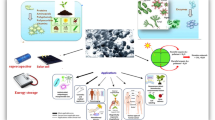Abstract
Egyptian blue has been identified in a painting from 1524 by the Italian artist Ortolano Ferrarese (Giovanni Battista Benvenuto). Egyptian blue is the oldest known synthetic pigment, invented by the Egyptians in the fourth dynasty (2613–2494 bc) of the Old Kingdom and extensively used throughout Antiquity. From about 1000 a.d., it disappeared from the historical record and was only reinvented in the late nineteenth and early twentieth century. The discovery of Egyptian blue in Ortolano Ferrarese’s painting from 1524 shows that Egyptian blue was in fact available in the period from which it is normally considered not to exist. The identification of Egyptian blue is based on optical microscopy supported by energy-dispersive spectroscopy and visual light photon-induced spectroscopy, and finally confirmed by Raman microspectroscopy.

St. Margaret by Giovanni Batista Benvenuto. National Gallery of Denmark.






Similar content being viewed by others
References
Jaksch H, Seipel W, Weiner KL, El Goresy A (1983) Egyptian blue—cuprorivaite. A window to ancient Egyptian technology. Naturwissenschaften 70:525–535
Riederer J (1998) Egyptian blue. In: FitzHugh E (ed) Artists’ pigments. Oxford University Press, Oxford
Damiani D, Gliozzo E, Memmi Turbanti I, Spangenberg JE (2003) Pigments and plasters discovered in the House of Diana (Cosa, Grosseto, Italy): an integrated study between art history, archaeology and scientific analyses. Archaeometry 45:341–354
Lazzarini L (1982) The discovery of Egyptian blue in a Roman fresco of the mediaeval period (ninth century A.D.). Stud Conserv 27:84–86
Gaetani MC, Santamaria U, Seccaroni C (2004) The use of Egyptian blue and lapis lazuli in the Middle Ages: the wall paintings of the San Saba Church in Rome. Stud Conserv 49:13–22
Lluveras A, Torrents A, Giráldez P, Vendrell-Saz M (2010) Evidence for the use of Egyptian blue in an 11th century mural altarpiece by SEM-EDS, FTIR and SR XRD (Church of Sant Pere, Terrassa, Spain). Archaeometry 52(2):308–319
Tite MS, Bimson M, Cowell MR (1987) The technology of Egyptian blue. In: Bimson M, Freestone IC (eds) Early vitreous materials. British Museum Occasional Papers, pp 39–46
Fouquè F (1889) Sur le bleu Ègyptian ou Vestorien. Bull Soc Fr Minéral 12:36–38
Laurie AP, McLintock WFP, Miles FD (1914) Egyptian blue. P R Soc Lond A—Conta 89(612):418–429
Minguzzi C (1938) Cuprorivaite: Un nuovo minerale. Period Mineral 3:333–345
Pabst A (1959) Structure of some tetragonale sheet silicates. Acta Cryst 12:733–739
Mazzi F, Pabst A (1962) Reexamination of cuprorivaite. Am Min 47:409–411
Rask V (2007) Ortolanos Den hellige Margrethe fra 1524. BSc thesis, School of Conservation, Copenhagen
Tite MS, Bimson M, Cowell MR (1984) Technological examination of Egyptian blue. In: Lambert JB (ed) Archaeological chemistry—III. American Chemical Society, Washington, pp 215–242
Pagès-Camagna S, Colinart S (2003) The Egyptian green pigment: its manufacturing process and links to Egyptian blue. Archaeometry 45(4):637–658
Kendrick E, Kirk CJ, Dann SE (2007) Structure and colour properties in the Egyptian blue family, M1 − x M′ x CuSi4O10, as a function of M, M′ where M, M′ = Ca, Sr and Ba. Dye Pigment 73:13–18
Cotton FA, Wilkinson G (1980) Advanced inorganic chemistry, 4th edn. Wiley, New York
Jones CJ (2002) d- and f-block chemistry. Royal Society of Chemistry, Cambridge
Putnis A (1992) Introduction to mineral sciences. Cambridge University Press, Cambridge
Pozza G, Ajò D, Chiari G, Dezuane F, Favaro M (2000) Photoluminescence of the inorganic pigments Egyptian blue, Han blue and Han purple. J Cult Herit 1:393–398
Verri G (2009) The spatially resolved characterization of Egyptian blue, Han blue and Han purple by photo-induced luminescence digital imaging. Anal Bioanal Chem 394(4):1011–1021
Acknowledgements
The first author wants to thank Kim Pilkjær Simonsen for many stimulation discussions and for help with figures. Irma and Georg Norlander Staal gave the first author substantial encouragement during the writing process. We are grateful to Troels Filtenborg, chief conservator at National Gallery of Denmark, who generously placed the samples at our disposal and offered instructive guidance to the third writer. Finally, we express warm thanks to Wim Fremout for prompt help with the MRS instrument and to Clara Lauridsen for assistance with the samples.
Author information
Authors and Affiliations
Corresponding author
Rights and permissions
About this article
Cite this article
Bredal-Jørgensen, J., Sanyova, J., Rask, V. et al. Striking presence of Egyptian blue identified in a painting by Giovanni Battista Benvenuto from 1524. Anal Bioanal Chem 401, 1433–1439 (2011). https://doi.org/10.1007/s00216-011-5140-y
Received:
Revised:
Accepted:
Published:
Issue Date:
DOI: https://doi.org/10.1007/s00216-011-5140-y




